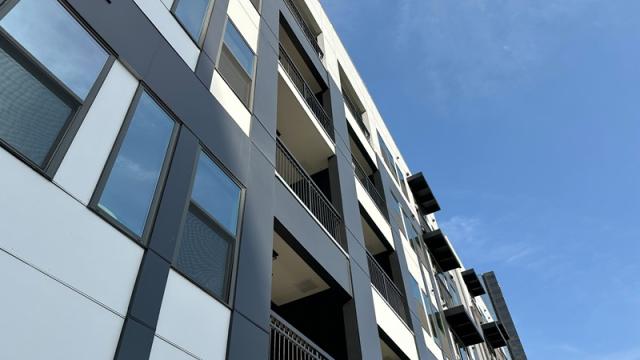
Rent growth has continued to decelerate, according to the latest February data from CoStar. Alongside the widening gap between supply and demand, this slowdown in rent growth reflects a rocky start to the year for the multifamily sector.
Rent growth slows to a crawl
Both month-over-month and year-over-year comparisons revealed a deceleration of rent growth. February’s 0.2 percent rise in asking rents failed to meet January’s revised rate of 0.3 percent but continues to remain positive.
Zooming out to the year-over-year perspective, February’s 0.7 percent rate of rent growth is the slowest annual gain since mid-2020. It marks a slowdown of almost 300 basis points compared to January of last year.
Deceleration felt nationwide
All four regions of the country are seeing rent growth slow down, with year-over-year rates not even cracking 1 percent, except in the Midwest. The Northeast and West both saw annual increases of 0.8 percent, while declines in the South deepened to negative 3.9 percent. Only the Midwest saw notable — though limited — rent growth, with an annual increase of 2.3 percent.
When viewed from the month-to-month perspective, increases were minimal, with little regional variation. Asking rents grew 0.2 percent in the Northeast, West, and Midwest, while the South posted an equivalent decline.
Midwest markets see the largest gains
When broken down by local markets, the Midwest dominated the charts for year-over-year rent growth. Louisville, Kentucky, which straddles the Midwestern and Southern regions, led the list with 3.3 percent rent growth, and three of the top spots were taken by Ohio markets, all of which have shown strong performance over the course of the last year.
Major markets in other regions, including the Northeast and West, also made the list. California’s Orange County, which closed 2023 as an unlikely winner, continues to remain ahead, taking the second spot, with 2.9 percent rent growth.
10 markets with greatest rent growth
| Local market | Year-over-year change in asking rent |
1 | Louisville, KY | 3.3% |
2 | Orange County, CA | 2.9% |
3 | Northern New Jersey, NJ | 2.7% |
4 | Cincinnati, OH | 2.3% |
5 | Washington, D.C. | 2.1% |
6 | Cleveland, OH | 2.1% |
7 | Norfolk, VA | 2.0% |
8 | Oklahoma City, OK | 1.8% |
9 | Columbus, OH | 1.8% |
10 | Kansas City, MO | 1.8% |
What do these markets with the greatest — if nevertheless modest — rent increases have in common? New multifamily supply in these metros has remained relatively limited, which has kept a healthy balance between supply and demand.
Oversupplied Sun Belt markets continue to see rents fall
The markets with the most dramatic declines continue to be the Sun Belt markets swamped with new inventory, with Austin, Texas hit hardest of all. A total of 19 major markets, most in the Sun Belt, saw negative rent growth, while three in the West broke even with no year-over-year change.
The markets facing the greatest challenges with rent growth have all seen a similar trajectory in recent years. All were recipients of large population inflows during the COVID-19 pandemic and have swung from a state of demand exceeding supply to the reverse.
10 markets with the greatest rent declines
Austin, which has seen the largest influx of new units relative to population size, continues to lead the charts for greatest fall in asking rent. The Texas metro, which is struggling with the greatest vacancy rate among all major markets, posted a negative 5.8 percent year-over-year change in asking rent, as of February.
All markets within the top 10 are within the Sun Belt. While most fall within the Southeastern U.S., the Southwestern market of Phoenix also made the list. This Arizona market has seen a similar trend of new construction following its pandemic-era population boom.
| Local market | Year-over-year change in asking rent |
1 | Austin, TX | -5.8% |
2 | Orlando, FL | -3.5% |
3 | Jacksonville, FL | -3.4% |
4 | Raleigh, NC | -3.4% |
5 | Atlanta, GA | -3.0% |
6 | Nashville, TN | -2.8% |
7 | Charlotte, NC | -2.5% |
8 | Phoenix, AZ | -1.9% |
9 | Dallas–Fort Worth, TX | -1.6% |
10 | Tampa, FL | -1.4% |
Month-over-month trends reflect same supply–demand dynamics
How does February rent growth compare to that of a month ago? The short-term picture mirrors the same trends seen from the annual perspective.
When comparing February rent growth to the revised January numbers, Kentucky’s Louisville again took the #1 spot, followed by St. Louis, Missouri. Midwest leaders Indianapolis, Cincinnati, and Columbus all made the top 10, but they were also joined by several markets in the West, including Sacramento, Portland, Seattle, and San Jose. These high-cost markets, which range from Northern California to the Pacific Northwest, are characterized by limited new development relative to population size.
| Local market | Year-over-year change in asking rent |
1 | Louisville, KY | 0.9% |
2 | St. Louis, MO | 0.7% |
3 | Memphis, TN | 0.6% |
4 | Sacramento, CA | 0.6% |
5 | Indianapolis, IN | 0.6% |
6 | Cincinnati, OH | 0.6% |
7 | Portland, OR | 0.6% |
8 | Columbus, OH | 0.5% |
9 | Seattle, WA | 0.5% |
10 | San Jose, CA | 0.4% |
Only six major markets saw asking rents drop compared to January, but all are within the Sun Belt region. Due to its oversupply, Austin again showed the most dramatic drop, at negative 0.4 percent.
Want more multifamily insights?
Join CoStar’s Jay Lybik for a recent analysis of the multifamily conditions for 2024.
Watch now (closed captioning available):
CoStar is the industry-leading source for information, analytics, and news about all areas of commercial real estate. Whether you’re an owner, investor, or apartment operator, you’ll find in-depth analysis from Jay Lybik and other experts to help you stay on top of the latest trends in the market. Learn more about CoStar.







